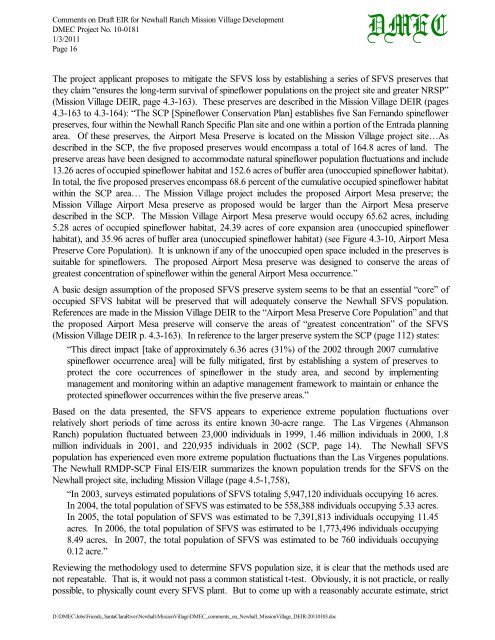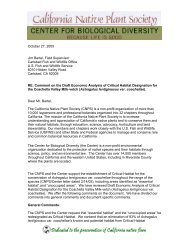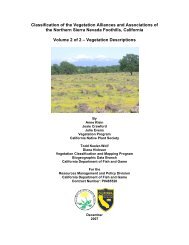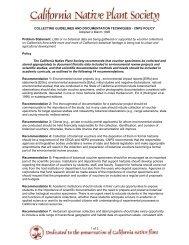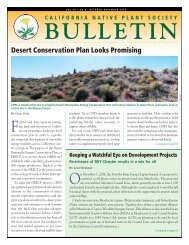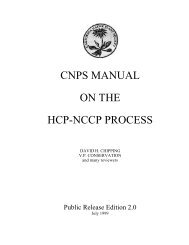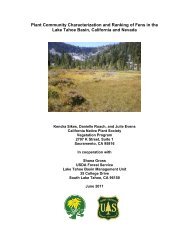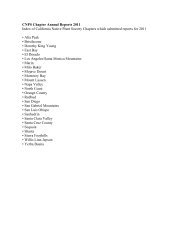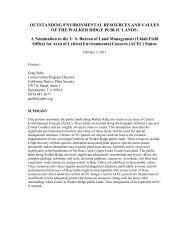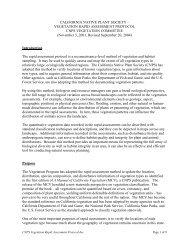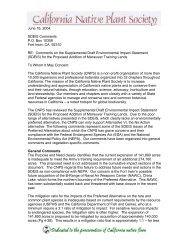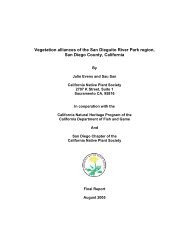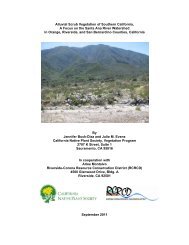David Magney Environmental Consulting - California Native Plant ...
David Magney Environmental Consulting - California Native Plant ...
David Magney Environmental Consulting - California Native Plant ...
Create successful ePaper yourself
Turn your PDF publications into a flip-book with our unique Google optimized e-Paper software.
Comments on Draft EIR for Newhall Ranch Mission Village Development<br />
DMEC Project No. 10-0181<br />
1/3/2011<br />
Page 16<br />
D:\DMEC\Jobs\Friends_SantaClaraRiver\Newhall-MissionVillage\DMEC_comments_on_Newhall_MissionVillage_DEIR-20110103.doc<br />
DMEC<br />
The project applicant proposes to mitigate the SFVS loss by establishing a series of SFVS preserves that<br />
they claim “ensures the long-term survival of spineflower populations on the project site and greater NRSP”<br />
(Mission Village DEIR, page 4.3-163). These preserves are described in the Mission Village DEIR (pages<br />
4.3-163 to 4.3-164): “The SCP [Spineflower Conservation Plan] establishes five San Fernando spineflower<br />
preserves, four within the Newhall Ranch Specific Plan site and one within a portion of the Entrada planning<br />
area. Of these preserves, the Airport Mesa Preserve is located on the Mission Village project site…As<br />
described in the SCP, the five proposed preserves would encompass a total of 164.8 acres of land. The<br />
preserve areas have been designed to accommodate natural spineflower population fluctuations and include<br />
13.26 acres of occupied spineflower habitat and 152.6 acres of buffer area (unoccupied spineflower habitat).<br />
In total, the five proposed preserves encompass 68.6 percent of the cumulative occupied spineflower habitat<br />
within the SCP area… The Mission Village project includes the proposed Airport Mesa preserve; the<br />
Mission Village Airport Mesa preserve as proposed would be larger than the Airport Mesa preserve<br />
described in the SCP. The Mission Village Airport Mesa preserve would occupy 65.62 acres, including<br />
5.28 acres of occupied spineflower habitat, 24.39 acres of core expansion area (unoccupied spineflower<br />
habitat), and 35.96 acres of buffer area (unoccupied spineflower habitat) (see Figure 4.3-10, Airport Mesa<br />
Preserve Core Population). It is unknown if any of the unoccupied open space included in the preserves is<br />
suitable for spineflowers. The proposed Airport Mesa preserve was designed to conserve the areas of<br />
greatest concentration of spineflower within the general Airport Mesa occurrence.”<br />
A basic design assumption of the proposed SFVS preserve system seems to be that an essential “core” of<br />
occupied SFVS habitat will be preserved that will adequately conserve the Newhall SFVS population.<br />
References are made in the Mission Village DEIR to the “Airport Mesa Preserve Core Population” and that<br />
the proposed Airport Mesa preserve will conserve the areas of “greatest concentration” of the SFVS<br />
(Mission Village DEIR p. 4.3-163). In reference to the larger preserve system the SCP (page 112) states:<br />
“This direct impact [take of approximately 6.36 acres (31%) of the 2002 through 2007 cumulative<br />
spineflower occurrence area] will be fully mitigated, first by establishing a system of preserves to<br />
protect the core occurrences of spineflower in the study area, and second by implementing<br />
management and monitoring within an adaptive management framework to maintain or enhance the<br />
protected spineflower occurrences within the five preserve areas.”<br />
Based on the data presented, the SFVS appears to experience extreme population fluctuations over<br />
relatively short periods of time across its entire known 30-acre range. The Las Virgenes (Ahmanson<br />
Ranch) population fluctuated between 23,000 individuals in 1999, 1.46 million individuals in 2000, 1.8<br />
million individuals in 2001, and 220,935 individuals in 2002 (SCP, page 14). The Newhall SFVS<br />
population has experienced even more extreme population fluctuations than the Las Virgenes populations.<br />
The Newhall RMDP-SCP Final EIS/EIR summarizes the known population trends for the SFVS on the<br />
Newhall project site, including Mission Village (page 4.5-1,758),<br />
“In 2003, surveys estimated populations of SFVS totaling 5,947,120 individuals occupying 16 acres.<br />
In 2004, the total population of SFVS was estimated to be 558,388 individuals occupying 5.33 acres.<br />
In 2005, the total population of SFVS was estimated to be 7,391,813 individuals occupying 11.45<br />
acres. In 2006, the total population of SFVS was estimated to be 1,773,496 individuals occupying<br />
8.49 acres. In 2007, the total population of SFVS was estimated to be 760 individuals occupying<br />
0.12 acre.”<br />
Reviewing the methodology used to determine SFVS population size, it is clear that the methods used are<br />
not repeatable. That is, it would not pass a common statistical t-test. Obviously, it is not practicle, or really<br />
possible, to physically count every SFVS plant. But to come up with a reasonably accurate estimate, strict


